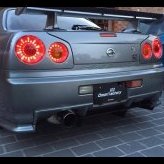Profec B - Install R34 Gtt
Announcements
-
Similar Content
-
Latest Posts
-
That looks good, but I think you're going to need much beefier side skirts now.
-
They are daft and there's a reason it never caught on. Steering feel? We don't need no stinking steering feel!
-
I gotta pull you up on this. It's driving me crazy. A shutter is something that closes, like over a window or in a cmera. The word you want is shudder. That LSD is clearly f**ked. Take it to a diff shop and get it disassembled and examined by an expert. YOu might have plates welded together or something equally crazy.
-
Define "starting to fail". Wy not just rebuild them?
-
Check the Nistune doco. There are a few assumptions being made here that might not be valid. I will list the things that occur to me: Base map. Base map for what? Base map for Z32? Then the cranking pulse width is probably wrong for an RB25. The extra 500cc of capacity might well be enough to prevent it from catching. Base map for RB25? I don't think you can load one of those into a Z32. You have to just make the settings correct for an RB25 in the Z32 base map. That is either K or the TIM to get the pulsewidth right. Loom. You bought a loom for an RB. And you plugged it into a Z32 ECU. Did you make sure that any iwre differences were swapped. From memory, there's at least a couple. And as per the others, I would suggest making sure that the fuel pressure is correct while cranking and that the injectors are actually flowing as expected. They really must come out and go on the bench, unless you do find that you have messed up as per above points. I would also suggest watching in Nistune to make sure that everything is reading correctly. That the correct binary flags are raised at the right time (like the crank signal), that there's no stupid values in K or TIM. That you have not got mismatched firmware for the ECU and/or a wrong image loaded.
-



Recommended Posts
Create an account or sign in to comment
You need to be a member in order to leave a comment
Create an account
Sign up for a new account in our community. It's easy!
Register a new accountSign in
Already have an account? Sign in here.
Sign In Now